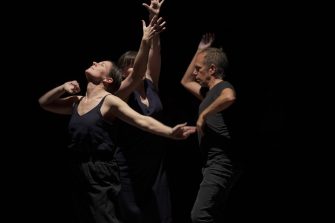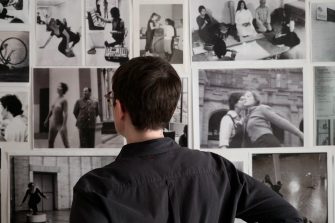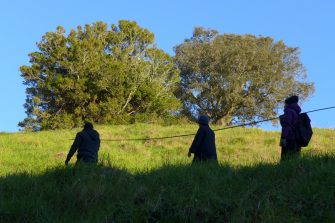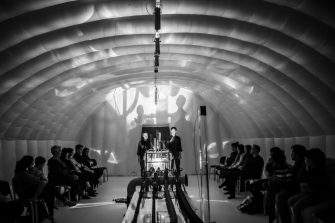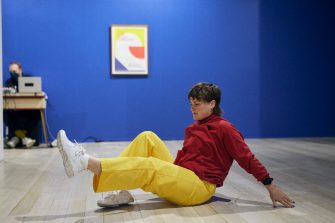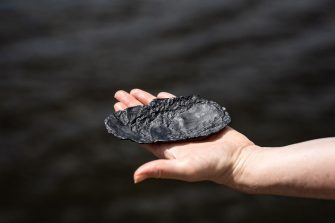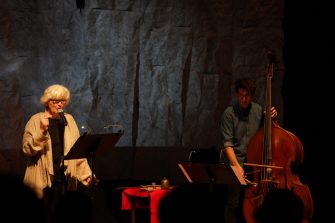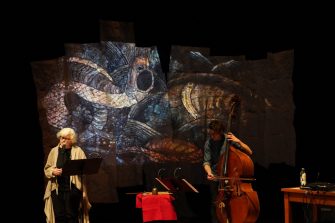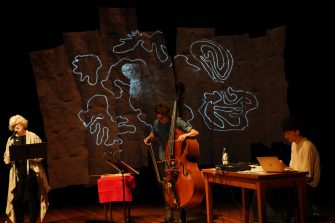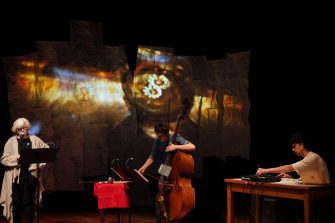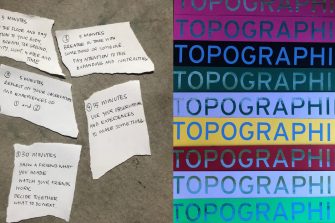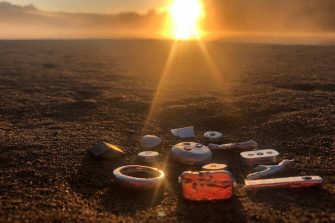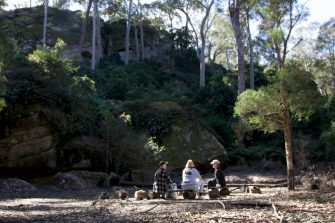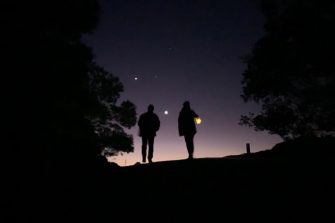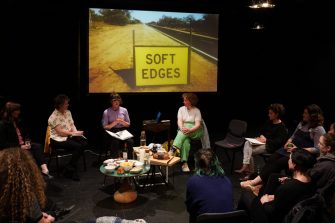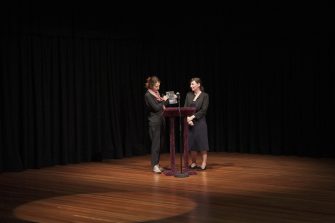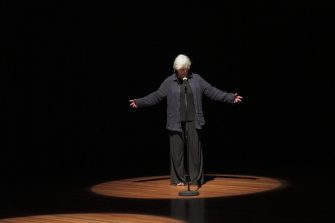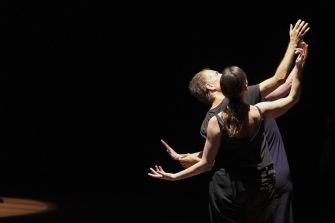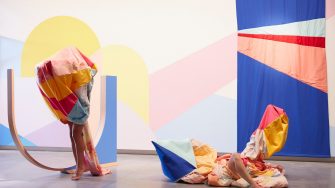
The Intermedial Composition Network (2015–) explores the creative practices of leading artists working in all media as a site of experiment, innovation, resilience and imagination. By intermedial composition we refer to the process of convergence across multiple art forms in the creative act, including the way in which compositional practices in one field might inform – and transform - those in another. This focus on intermediality within our collective both works with and against our post-disciplinary historical moment, honouring both discipline specificity and intermedial experimentation. Alongside practice, our members understand that insight into creative process is enhanced by interdisciplinary conversation, and that such insights reveal novel methods and outcomes and support their application to broader fields of social and cultural activity.
Aims & background
Established by Erin Brannigan and Stephanie Bishop in the UNSW School of the Arts & Media (SAM), the collective has undertaken research workshops across 2015/16 and 2021/22 with SAM scholars representing the different branches of creative practice, curriculum and research in the school. In 2022 new members were invited from the UNSW School of Art & Design, as well as local and international artist-scholars from outside UNSW.
The aim of the group is to acknowledge, consolidate and build on research expertise in compositional knowledge and intermediality in both practice and theory both locally and internationally, providing a platform for such work already existing within UNSW Arts, Design & Architecture and support for nurturing new research projects and collaborations. From this base, the network extends to include peer artist-researchers and industry contacts who are essential to our work. Through industry partnerships we will engage the public through a focus on developing literacies related to intermedial work.
Significance
Despite interdisciplinarity being a popular term for research approaches in academia, there is an absence of rigorous research into intermedial compositional strategies and terminology in practice, that is, how terms might ‘translate’ across art forms. This results in the pressing problem of low arts literacy when it comes to work outside of the traditional, siloed art forms, which impacts on audience engagement and participation, funding and programming. In an attempt to ‘catch up’ with intermedial developments in practice, this research group focuses on the generation and process stages of creative development through engagement with artists’ writing and practice.
Membership
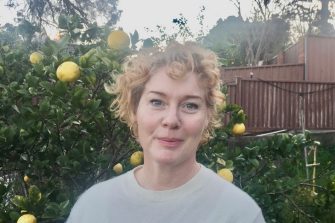
Dr Erin Brannigan (Convenor)
Erin Brannigan is Associate Professor in Theatre and Performance at UNSW Sydney. She is of Irish and Danish political exile, convict, and settler descent. Her publications include Dancefilm: Choreography and the Moving Image (New York: Oxford University Press, 2011) and Choreography, Visual Art and Experimental Composition 1950s -1970s (London: Routledge, 2022). She has published various chapters and articles in film, performance and dance journals and anthologies. Her current research project is Precarious Movements: Dance and the Museum with Tate UK, National Gallery of Victoria, Art Gallery of NSW, Monash University Museum of Art, Perth Institute of Contemporary Arts, Shelley Lasica and Zoe Theodore. A second monograph associated with this project is forthcoming: The Persistence of Dance: Choreography as Concept and Material in Contemporary Art (Michigan University Press, 2023).
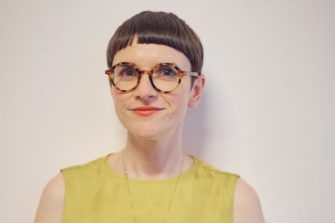
Dr Diana Baker Smith
Diana Baker Smith is an artist and lecturer in the UNSW School of Art & Design. Her artistic practice is collaborative, research driven, and underpinned by feminist methods. Her recent projects engage with art historiography and its fictions, spanning moving image, performance, photography, and text. They include She Speaks in Sculpture (UTS Art Gallery, Sydney, 2022), The Lost Hour (Contemporary Art Tasmania, Hobart, 2022), Tasks yet to be composed for the occasion (Artspace, Sydney, 2021) and Opening Night (National Gallery of Australia, 2020). She is currently working on a solo exhibition at Penrith Regional Gallery engaging with the archive and former home of the Australian modernist artist Margo Lewers. Baker Smith is a member of the art collective Barbara Cleveland, whose works are held in collections including Artbank, Museum of Contemporary Art, Monash University Museum of Art, Queensland Art Gallery of Modern Art, and Art Gallery of NSW.
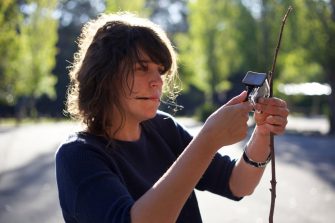
Dr Clare Britton
Based on Bidgigal Land, Clare Britton is an artist interested in attention, time, and landscapes. Clare creates original images (sculpture, video, photography, production design) and experiences (exhibitions, performances, walks). Clare’s work is informed by collaboration and explores how visual art and creative processes interact with other types of research. Clare's approach is shaped by her experience creating original projects with writers, performers, sound artists, choreographers, and video artists since 2000. Clare's work has attracted awards for sculpture, performance design & research and toured in Australia and internationally. Her time as part of the performance collective My Darling Patricia (2004-14) informs her process. Clare facilitates the Magnetic Topographies research group with artists Therese Keogh and Kenzee Patterson and is a resident artist at Carriagworks. A Sidney Myer Creative Fellow (2014), Clare holds a Masters of Studio Art (2016) and a Doctor of Philosophy (2020) from Sydney College of the Arts, the University of Sydney, where she is a Lecturer in Visual and Contemporary Art. Her PhD research project, A Week on the Cooks River, was completed under the supervision of Julie Rrap, Mikala Dwyer and Ann Elias. Clare’s work respects the fact that working in Australia means working on Aboriginal Land.
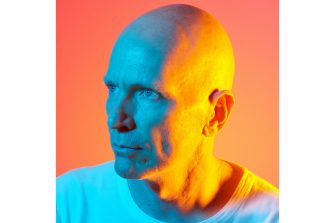
Dr Drew Crawford
Associate Professor in Composition in the Department of Music at the University of Southampton, Drew Crawford is an Australian composer, producer, sound-designer and songwriter whose work spans theatre, opera, contemporary dance, pop & EDM, cabaret, installation, sound design, radio, tv, film, the concert hall, and digital platforms. His diverse output has been performed across Europe, North America and Australasia, and been commissioned & presented by some of Australia’s leading performing arts organisations. Relocating to the UK in 2016, his current research interests and projects include site-responsive works for live spatialised musicians and electronics, and electronic dance-pop music under the name both/and.
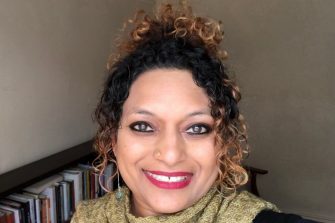
Dr Roanna Gonsalves
Roanna Gonsalves is a writer with an interdisciplinary practice. She is the author of The Permanent Resident (UWAP) published in India and South Asia as Sunita De Souza Goes To Sydney (Speaking Tiger Books). The book won the NSW Premier’s Literary Award Multicultural Prize 2018 and was longlisted for the Dobbie Literary Award 2018. Roanna’s series of radio documentaries, On the tip of a billion tongues, commissioned and broadcast by Earshot, ABC RN, is an acerbic socio-political portrayal of contemporary India through its multilingual writers. Roanna was born and raised in Mumbai, India, and attended St. Xavier’s College. Her social-satirical radio essay Doosra: The life and times of an Indian student in Australia was commissioned and broadcast by ABC RN.
Roanna is a recipient of the Vice Chancellor's Award for Teaching Excellence 2022, the Prime Minister’s Australia Asia Endeavour Award and the NSW Premier's Literary Award. She is co-founder co-editor of Southern Crossings. She has been an invited Keynote Speaker, Chair and panelist at numerous literary events including at the Sydney Writers' Festival, the Edinburgh International Book Festival, the Jaipur Literature Festival, the Goa Literature Festival and many others. She has been teaching, supervising and mentoring emerging prose writers and screenwriters within communities, schools, literary organizations and institutions such as New York University Sydney, UNSW, Western Sydney University, Macquarie University and the Australian Film, Television and Radio School (AFTRS). She is a recipient of grants through the Australia Council for the Arts, is a recipient of fellowships and residencies at Varuna and Bundanon, was the UNSW – Copyright Agency Writer-in-Residence 2018 and received The Bridge Awards’ inaugural Varuna – Cove Park Writing Residency 2019 (Scotland). Her research interests are in the sociology of literature, social media, creativity studies, and postcolonial literatures. She serves on the Board of Writing NSW and on the International Project Reference Group for the ARC-funded project 'Connecting Asia Pacific Literary Cultures. For more information, see roannagonsalves.com.au
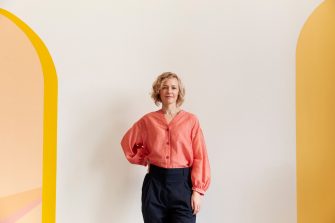
Dr Rochelle Haley
Rochelle Haley is a Senior Lecturer and researcher at the UNSW School of Art & Design. She is also an artist engaged with painting, drawing, choreography and performance to explore relationships between bodies and physical environments. For over 10 years Haley has worked at the forefront of the intersection of visual arts and dance: an emergent area of research gaining international momentum. Her interdisciplinary approach to movement merges painting and choreographic processes to investigate space structured around the sensation of the moving body. Haley’s work aims to re-imagine the dynamism of material surfaces of representation to discover methods that are sensory, kinaesthetic, affective and rhythmic. She has exhibited internationally and at leading national venues including UQ Museum, Bundanon Museum, Museum of Contemporary Art Sydney, Hazelhurst Regional Gallery and UNSW Galleries. Her work has been profiled on ABC Radio National, The Guardian, The Sydney Morning Herald, The Australian, Art Monthly Australia, Artist Profile Magazine and Art Collector.
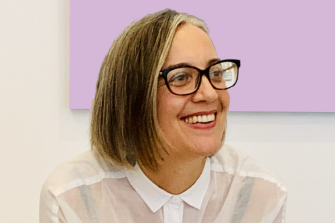
Dr Bianca Hester
Bianca Hester is an artist, writer and educator engaged in relational place-based practice with a focus on materiality. Her research explores entanglements between colonial inheritance, environmental crisis, human-nonhuman bodies, extinction and regeneration registered within specific locations, and across timescales. Employing feminist methodologies, projects combine experimental fieldwork, engaging the geologic record (in archives and in situ), embodied site-writing, sculptural production and performed actions. This approach results in an expansive form of process-based public art that unfolds in dialogue with a range of collaborators, interlocutors and participants to mobilise aesthetic encounters attuned to engaging the present – and future – otherwise.
Bianca has exhibited widely within Australia and internationally, with works held in private and public collections, including the Museum of Contemporary Art. She is a Sidney Myer fellow (2016) and a continuing member of the collaborative trio Open Spatial Workshop (2003-ongoing). Her project A world, fully accessible by no living being (2011) won the Melbourne Prize for Urban Sculpture. The book Converging in time (with Open Spatial Workshop, 2017) was published by MUMA and was the winner of the Museums Australia Publication Design Awards for major exhibition catalogue, and the AAANZ best University Art Catalogue in 2018. She is an Associate Investigator with the ARC Centre of Excellence for Australian Biodiversity and Heritage (CABAH), on the Editorial Committee for the Australian and New Zealand Journal of Art (AANZJA) and is currently a Co-Director of Research and Engagement in the School of Art and Design. www.biancahester.com & www.osw.com.au
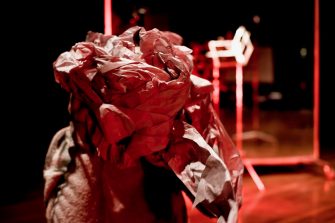
Dr Nikki Heywood
Nikki Heywood is a Sydney-based interdisciplinary artist working across dance, performance, writing and live art. Her practice has centred on devising and directing original performance work with a focus on embodiment. Her work has toured inter/nationally.
She is interested in the voice as an energetic force through and of the body, studying classical singing training as well as extended vocal techniques and developing expanded experimental scores for voice and instrument.
Heywood has informed a generation of performance artists: leading and participating in collective creation and collaboratively devised projects; running skills-based workshops for students and emerging practitioners and assisting the creative process of many artists as a mentor and dramaturg. Awarded a highly commended DCA in 2016 (thesis title: Undoing Discomfort: being real/becoming other in an embodied performance practice, University of Wollongong), Heywood is currently working with collaborator Mark Cauvin (double bass) on an existential chamber opera ‘Broadcast into Oblivion’.
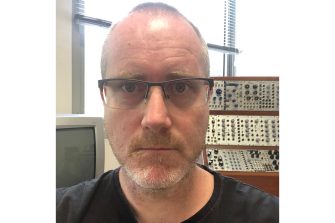
Dr Adam Hulbert
Adam Hulbert researches into media and music, and is active as an experimental composer, performer and sound designer. He founded and performs with the Sydney City Humanoid Electronic Modular Ensemble. He directs the Sound Lab Ensemble at UNSW. He has a range of public works and commissions, including a three year residency with radio 2SER to remix free-to-air television live, a month-long installation in Martin Place using archival audio and motion sensors, video art for Deborah Kelly and live performance in the Sydney Opera House of a commissioned radio dramatisation of an unpublished work by author John Birmingham.
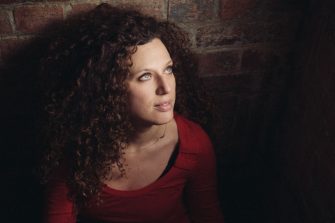
Dr Sonya Lifschitz
"A recital for the modern day...Lifschitz is a theatre actor, an orchestra and a soloist all at the same time." - The Age
Sonya Lifschitz is a pianist working across many contexts, with repertoire spanning from 15th century Faenza Codex to works written for her today. Described as “a life force of extraordinary density and capacity”, Sonya’s artistry combines bold adventurousness with “miraculous keyboard technique and musicianship” (Woodstock Times) to create work that positions classical and art music at the cutting edge of contemporary performance practices. She is active as a soloist, creative collaborator, artistic director, educator, radio personality and arts advocate.
Sonya debuted with the Melbourne Symphony Orchestra at age 18, performing Rachmaninoff’s Piano Concerto no. 2 which was televised on SBS TV. Since then, she has performed as a soloist on major international stages to critical acclaim including the Barbican Centre (London), De Doelen (Rotterdam), Bargemusic (New York), Detroit Institute of Art (USA), Venice Biennale (Italy), and in many of Australia’s major international arts festival, including Adelaide (AF), Sydney (SF), Melbourne (MIAF), Brisbane (BF), Canberra (CIMF) and Darwin (DF) Festivals; and other prestigious festivals including Extended Play, Metropolis, MONAFOMA, Four Winds and Ten Days on the Island.
Sonya regularly performs with members of Sydney, Melbourne and Queensland Symphony Orchestras and the Australian Chamber Orchestra, and with pioneering new music ensembles, including Ensemble Offspring, Topology, Clocked Out, and members from Bang on a Can All-Stars (USA) and Eighth Blackbird (USA).
A Fulbright Scholar, Sonya studied with the legendary American pianist Leon Fleisher and is currently Head of Music Performance at UNSW Sydney.
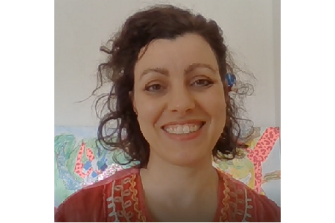
Dr Bryoni Trezise
Bryoni Trezise is Senior Lecturer in Theatre and Performance Studies at the University of New South Wales and works on Bidigal land. Her major publications win prizes for developing interdisciplinary conversations between performance aesthetics, pedagogies and cultures, and have been published in leading journals including Performance Research, Research in Drama Education and Convergence as well as two books. Her most recent projects focus on image and ideals of children and young people, forthcoming in Performing Contemporary Childhoods: Being and Becoming a Viral Child (Routledge, 2023). Her strong advocacy for creative approaches to learning has been recognised by both Dean’s and Vice Chancellor’s teaching awards, and in 2021 Bryoni was awarded the prestigious Children’s Book Council Australia Charlotte Waring Barton Award for her unpublished middle grade manuscript. Bryoni shares her interest in languages of creative process via a range of media outlets. Her work has appeared in over 35 reviews for The Conversation, RealTime, The Canberra Times and on ABC Radio.
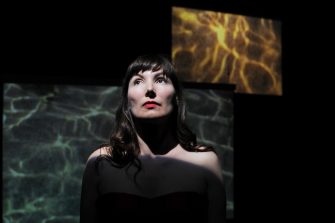
Dr Nalina Wait
Dr Nalina Wait is a dance artist, pracademic, and Dance lecturer (ACPE) with a particular interest in improvisation. She is a pākehā of Éireannach (Irish) settler descent, who lives in Bidgigal/Gadigal Country, Eora, Sydney. She is curious about processes of somatic intelligence cultivation in the practice and performance of improvisation and has worked as a professional dance artist for more than 20 years. She has performed nationally and internationally in works by Sue Healey (2002-2021), Hans Van Den Broeck (SOIT), Sydney Performance Group, Danceworks (Sandra Parker), Rosalind Crisp, Nikki Haywood, Lizzie Thomson, Joan Jonas, and Marina Abramović. She has also taught contemporary dance technique, composition, improvisation, and somatics at many of Sydney’s pre-professional dance institutions. Her manuscript Improvised Dance: (In)Corporeal Knowedges was published by Routledge in 2023.

Nicki Polykarpou (Research Assistant)
Nicki is interested in the creative process, creative decision-making and composition in performance-making when artists are working towards an unknown.
Upcoming Events
Glossary Workshop: February 2024
Artists Spotlights 2024: Four events - to be announced
Past Events
-
A work in progress showing, ‘something about horizons’ by network member Nikki Heywood together with Clayton Thomas, Harry Levey and Sam James.
The impulse for this work is to compose a live spatial installation for an (imagined) experience where a mind/ a consciousness hovers between states of existence.
It is a proposition, a reverie that lightly contemplates the 'pointy end’, making sense of matter and motion... something about uncertainty and letting go.
We are still here, but for how long and in what condition?
What will the next stage, the next Bardo of our existence, be like? Can we even imagine it? And what about our senses of perception? Will there be feeling? What will it sound like?
The focus on ‘hearing’ mirrors the development of the embryo’s first sense, as well as being possibly the last sense to remain at and around the event of dying.
A state Tibetan Buddhists call
‘BARDO THODOL: liberation in the intermediate state through hearing’.
About the artists
NIKKI HEYWOOD is a Sydney-based interdisciplinary artist working across dance, performance, writing and live art. A performance creator with a deep focus on embodiment, her long professional practice has centred upon collaboration, devising and directing original performance. Since the 90’s her work has been presented at venues such as Performance Space, PICA (Perth), Adelaide Festival, Theatreworks and NGV (Melbourne), Griffin Theatre, PACT, Brisbane Powerhouse and Metro Arts, Magdalena Women’s festivals in Colombia, New Zealand and Brisbane, Edinburgh Festival.
SAMUEL JAMES is a video artist and projection designer since 1994, working on over 200 projects with live performance. He makes art films with performance makers & participates in international residencies to develop video works on phenomenology.
HARRY LEVEY is an early career multi-instrumentalist working across post punk and ambient, playing & touring with bands. Explores experimental sound design for durational performance.
CLAYTON THOMAS’s approach to the bass is inspired by the master improvisers Barre Phillips, Peter Kowald, Henry Grimes and William Parker. Building a unique voice through 20 years of global collaboration, his viewpoint centres on shared expression, in-situ composition and utter surprise.
-
Network member Clare Britton, together with Therese Keogh of Magnetic Topographies, presented an Artist Spotlight on the 23rd August in the Esme Timbery Creative Practice Lab at UNSW.
The aim of the Spotlight was to discuss and obtain feedback on Magnetic Topographies’ proposed teaching pack which is to be shared with educators across areas of creative and collective place-based practice. The teaching pack will include a compilation of provocations for creative practice from artists, writers, researchers, dancers, poets and designers, which will then be able to be used by themselves and others as a shared teaching resource.
Clare and Therese shared some of the provocations with the attendees and asked for feedback on the concept of the pack in general. At the end of the session, Magnetic Topographies interpreted the feedback and discussion into a provocation in itself - a one hour process from the Intermedial Composition Network to be incorporated into the proposed teaching pack (see photo below).
Who are Magnetic Topographies?
Clare Britton, Kenzee Patterson and Therese Keogh form Magnetic Topographies, an interdisciplinary working group that brings people together with diverse areas of interest and from varying fields, with an underlying focus on collective spatial practice. We’ve hosted reading groups, workshops, walks, meals and public gatherings aimed at creating a space for people to learn from one another and develop collective methods for ethical place-based relations, and collaborative imaginings for the present and future. You can see some more of our work here: https://magnetictopographies.cargo.site/
-
Improvised Dance: (In)Corporeal Knowledges
Speakers: Nalina Wait, Sanja Andus L’Hotellier
Improvised performance: Martin del Amo, Nikki Heywood, Jane McKernan, Nalina Wait.
-
Drew Crawford presented on We'll find out when we get there a new, 60-minute, site-responsive work for live musicians and electronics, flexibly designed to be performed in and toured to mid-sized public art spaces around the UK. Exploring the relationship of sound and aural architecture, the work is situated at the intersection of performance and installation. In this seminar, composer/creative director Drew Crawford discussed how the work is being developed in partnership with Plus Minus Ensemble and John Hansard Gallery, and how he is experimenting with collaborative theatre-, choreography- and studio-based creative practices in his compositional process.
Alice Purton (Plus Minus Ensemble) performing in the John Hansard Gallery as part of a creative workshop for We'll find out when we get there. Photo credit: Nathan Thomas
-
Two half day face to face workshop with the following participants: Erin Brannigan, Clare Britton, Drew Crawford, Nikki Heywood, Sonya Lifschitz, Cleo Mees, Bryoni Tresize, Nalina Wait, Nicki Polykarpou (RA).
In 2022 and 'post-Covid,' the Intermedial Composition Network expanded to include a wider network of ADA researchers and industry-based participants as well as national and international partners, and met to plan a program of activities for that broader network. At this workshop, participants were asked to present a short presentation on a ‘tool’ they use to create work or present case studies on intermedial work in order to identify key interests, needs and challenges of the cohort and discuss relevant concerns and terminologies together. The group planned a series of activities for the next 12-24 months including artist spotlights, a glossary project, reading group, a website and a series of podcasts to plot out some critical terrain.
-
Online workshop with the following participants: Stephanie Bishop, Erin Brannigan, Sonya Lifschitz, Briony Trezise, Cleo Mees (RA)
This workshop focused on finding common ground and potential avenues for deeper research through the exchange of creative vocabularies, sharing work-in-progress, and participating in timed creative exercises. Discoveries included a strong shared interested in experimentalism and process; meaningful connections between others’ vocabularies; the value of taking language from one discipline and applying it to another; and new ways of thinking/accessing/troubleshooting member’s own work.
Future planning included a proposed roundtable workshop later in the year; the value of doing work with a focussed exchange of work in progress, language and strategies; and the possibility of broadening the network’s membership.
-
Online workshop with the following participants: Stephanie Bishop, Erin Brannigan, Brigid Costello, Michael Hooper, Bryoni Trezise, Cleo Mees (RA)
Members met to share and participate in discussion surrounding where intermediality had surfaced in their recent work, research and teaching. Key terms discussed included: the disciplinary and interdisciplinary; the materials of practice; rhythm, the visual and representing process; slow scholarship; high theory; literacy, access and spectatorship. Future planning included exploring future partnerships with international and industry partners; possible ways to frame this work; podcasts; publications of research papers and non traditional research outputs.
-
Participants: Stephanie Bishop, Brigid Costello, Nikki Heywood, Michael Hooper, Sam James, Alistair Noble, Alyssa Rothwell, Lizzie Thomson, Bryoni Tresize, Nalina Wait
This one-day event involved the key members of the network working with academics and artists to refine some terms for intermedial research - poetics, polyphony, perception - as they emerged from the day retreat held in February 2016. Each participant was invited to present on a key topic, submit opening questions and contribute to a ‘casual manifesto’ in order to summarise a collective definition of the key terms with a view towards a future publication.
-
Participants: Stephanie Bishop, Erin Brannigan, Brigid Costello, Michael Hooper, Bryoni Trezise
The group met to define and discuss collaborating on a new model of intermedial composition for multiple outcomes including investigating common ground that might exist across the disciplines. The network committed to a sustained enquiry into the processes by which creative work takes shape, examining the extension of ideas into form, the experience of invention, and the dynamic relationship between different art forms.
The five academics shared their current research, led group writing exercises and mapped areas of confluence. Future planning included feeding key findings from the retreat into the network’s next events such as: a workshop on compositional speculations: poetics, polyphony and perception; a publication of a small co-authored monograph; and a proposed symposium inviting national and international speakers to present papers, art works and performance work.
Intermedial Publications
-
D. Baker Smith and K. Blackmore, 2022, Brief Illuminations Between Interruptions, single channel 4K video, 13.12 minutes. Commissioned for Video Commission by Ngunungulla Regional Art Gallery, Bowral, 2022.
D. Baker Smith, 2022, She Speaks in Sculpture, two channel 4K video, 9.35 minutes. Commissioned for She Speaks in Sculpture at UTS Art Gallery, Sydney, 2022.
D. Baker Smith, 2022, The One Hour Concert (Hobart), live performance, 60 minutes. Commissioned for Contemporary Art Tasmania, Hobart, 2022.
D. Baker Smith, 2021, The Lost Hour, single channel HD video, 15:50 minutes. First presented at Tasks yet to be composed for the occasion, Artspace Sydney. Subsequently presented at the Ravenswood Australian Women’s Art Prize, Sydney, 2021; Phillipa Cullen: Know my Name, National Gallery of Australia, Canberra; Contemporary Art Tasmania, Hobart; The Condensery, Somerset Regional Art Gallery, Toogoolawah, 2022.
D. Baker Smith, 2021, The One Hour Concert, single channel 4K video, 15:50 minutes. First presented at Tasks yet to be composed for the occasion, Artspace Sydney. Subsequently presented at Phillipa Cullen: Know my Name, National Gallery of Australia, Canberra; Contemporary Art Tasmania, Hobart, 2022.
D. Baker Smith, V. Tello, 2020, Opening Night (The Order of Arrangements), single channel HD video, 17.15 mins. Commissioned for Know my Name Conference, National Gallery of Australia, 2020. Subsequently presented at: All About Women, the Sydney Opera House, 2021 and quietly, carefully, casually, Sarah Cottier Gallery, Sydney, 2022.
D. Baker Smith, 2020, 'Sculptures That Go Home at Night: On Labour, Performance and Re-enactment', in Atwood D; Russell F (ed.), Art of Laziness: Contemporary Art and Anti-Work Politics, Art + Australia, Melbourne, pp. 63 - 80
D. Baker Smith, K. Blackmore, F. Barrett, K. Doley, 2019, This is a Stained Glass Window, single channel HD video, 13.28 minutes. First presented at Sullivan+Strumpf Gallery, Sydney, 2019. Subsequently presented at Goulburn Regional Gallery, 2020; Penrith Regional Gallery, 2021; Melbourne International Film Festival, 2022.
-
A River Ends as the Ocean with Aunty Rhonda Dixon Grovenor and Astrida Neimanis for the 13th Shanghai Biennale Bodies of Water. Sydney and Power Station of Art, Shanghai. 2021
Polar Force- Speak Percussion and Philip Samartzis. Carriageworks Sydney Festival 2023, Noorderzon Festival, Groningen, Netherlands, 2019. Ruhrtriennale, Essen, Germany, 2019. CyberArts exhibition, The Prix Ars Electronica, Linz, Austria, 2019. Transart Festival, Bolzano, Italy, 2019. PICA, Perth, 2019. Victorian Arts Centre, Melbourne, 2018
The Nightline Ros Oades, Bob Scott and collaborators (production designer) Urban Theatre Projects, Right Here Right Now festival 2018, the Rising Festival, Melbourne 2021, Sydney Festival 2022, Adelaide Festival 2022
Walking Wolli Creek with Alexandra Crosby for Sydney Review of Books (co-author), 2022
Magnetic Topographies Research Group (facilitator) ongoing
The Mullets (mullet) ongoing
Arts House Culture Lab Residency We Drive So Fast it Feels Like Falling. Emily Parsons-Lord (collaborating artist) 2022
One Space One (in development) Aura Go with Tomoe Kawabata (director). Developed through the Musica Viva FutureMakers Program with support from Monash Academy of Performing Arts. 2019
BRIGHTNESS (in development). Choreographer Kristina Chan (collaborating artist, production design) Developed at Critical Path, Mondrook Community Hall, Io Myers Studio at the Esme Timbery Creative Practice Lab (CPL) in the School of the Arts & Media at UNSW. Funded by Australia Council for the Arts and Create NSW. Special thanks to Io Myers Studio and Readymade Works for their support. ongoing
-
The Persistence of Dance: Choreography as Concept and Material in Contemporary Art. Michigan University Press, 2023. Contracted November 2021, due for release June 2023.
Choreography, Visual Art and Experimental Composition 1950s–1970s. London: Routledge, 2022.
Dancefilm: Choreography and the Moving Image. Oxford University Press, New York, 2011.
Platform Paper #25: Moving Across Disciplines: Dance in the Twenty-First Century. Sydney: Currency House, 2010.
Brannigan, E., Day, M., & Thomson, L. (2018). ‘Research as Co-Habitation: Experimental Composition across Theory and Practice,’ pp. 218-263. In Performing Process: Sharing Practice, Eds. Blades, H. and Meehan, E. London: Intellect.
Wait, N. & Brannigan, E. (2018). ‘Non-Competitive Body States: Corporeal Freedom and Innovation in Contemporary Dance,’ pp. 283-304. In Oxford Handbook of Dance and Competition, Ed. Sherril Dodds. New York: Oxford University Press.
Brannigan, E. (2016). ‘Yvonne Rainer’s “Lives of Performers”: an undisciplined encounter with the avant-garde,’ pp. 517-536. In The Oxford Handbook of Dance Screen Studies, Ed. Douglas Rosenberg. New York: Oxford University Press.
Brannigan, E. ‘Choreography as Concept, Dancing as Material,’ Performance Research ‘ON (UN)KNOWNS,’ editors Hetty Blades, Scott deLahunta and Lucía Piquero, Vol. 26, No. 2 (2022): pp. 24-31.
Brannigan, E. ‘Transposing Style: Martin Del Amo’s New Solo Works,’ Brolga 36 (2012): pp. 25-30.
Brannigan, E. ‘Micro-choreographies: The Close-up in Dancefilm,’ International Journal of Performance Arts and Digital Media 5:2 (2009): pp. 121-139.
Brannigan, E. ‘“La Loïe” as Pre-Cinematic Performance – Descriptive Continuity of Movement’, Senses of Cinema 28, Sept-Oct (2003). Online: http://sensesofcinema.com/2003/feature-articles/la_loie/
Brannigan, E. 'Motion Pictures.' Writings on Dance 17 (1998): pp. 1 – 84.
-
2023 We’ll find out when we get there – a site-responsive performance piece for live musicians and electronics for Plus Minus Ensemble and Tim Hand, John Hansard Gallery, United Kingdom.
-
Haley R, 2022, Like Nobody's Watching, 52 ACTIONS, Penrith Regional Gallery, 27 August 2022 - 20 November 2022, medium: cotton drill, calico, cotton thread, dye, ink, pastel, oil stick, charcoal, chalk, conte, magnets, bamboo wadding, feather down, and performance 20min duration 28 Oct 2022, at: https://www.penrithregionalgallery.com.au/events/52-actions/
Haley R, 2022, Dance on a couch by an open window (after Boyd), From Impulse To Action, Bundanon Art Museum, Illaroo, 29 January 2022 - 12 June 2022, medium: acrylic paint, beech timber, canvas, calico, cotton drill, fabric dye, crayon, pastel, ink, charcoal, feather down, magnets, rope, and performance 20min duration 29 Jan 2022 and 28 May 2022., at: https://www.bundanon.com.au/whats-on/from-impulse-to-action/#:~:text=At%20its%20heart%2C%20From%20impulse,artists%20past%2C%20present%20and%20future.
Haley R, 2021, Ever Sun Laneways, City Art Laneways, Wilmot Street Sydney, 22 January 2021 - 11 July 2021, medium: acrylic discs, steel, wire, and performance 20min duration 25 Jan 2021 and 11 March 2021 at: https://www.cityartsydney.com.au/artwork/ever-sun/
-
2023 Dust of these domains in SITEWORKS. Bundanon Museum of Art, 26 November 2022-26 February 2023
2022 Reading Walking Lithic Bodies, in Perspectives on Place. Sydney: Museum of Contemporary Art, 30 April 2022 - 30 April 2022.
2022 'Moving in memory of lava flows: between Te Kōpuke Mount St John and Te Tokaroa Meola Reef', in B. Crone B, S. Nightingale & P. Stanton (ed.), Fieldwork for Future Ecologies: radical practice for art and art-based research, Onomatope, The Netherlands, pp. 307 - 324.
2021 Constellating bodies in temporary correspondence in Perspectives on Place: Works from the MCA Collection relating to land, mapping and environmental change, curated by Anneke Jaspers. Sydney: Museum of Contemporary Art.
2021 Groundwork. Melbourne: Perimeter Editions #069
2021 'Encountering lithic bodies: moving in memory of lava flows', ASLEC-ANZ (Association for the study of Literature, Environment and Culture, Australia and New Zealand), Wellington, Aotearoa New Zealand, presented at Conversations beyond human scales, Wellington, Aotearoa New Zealand, 23 November 2021 - 26 November 2021
2020 Sandstone, Lost Rocks series, Hobart: A Published Event.

